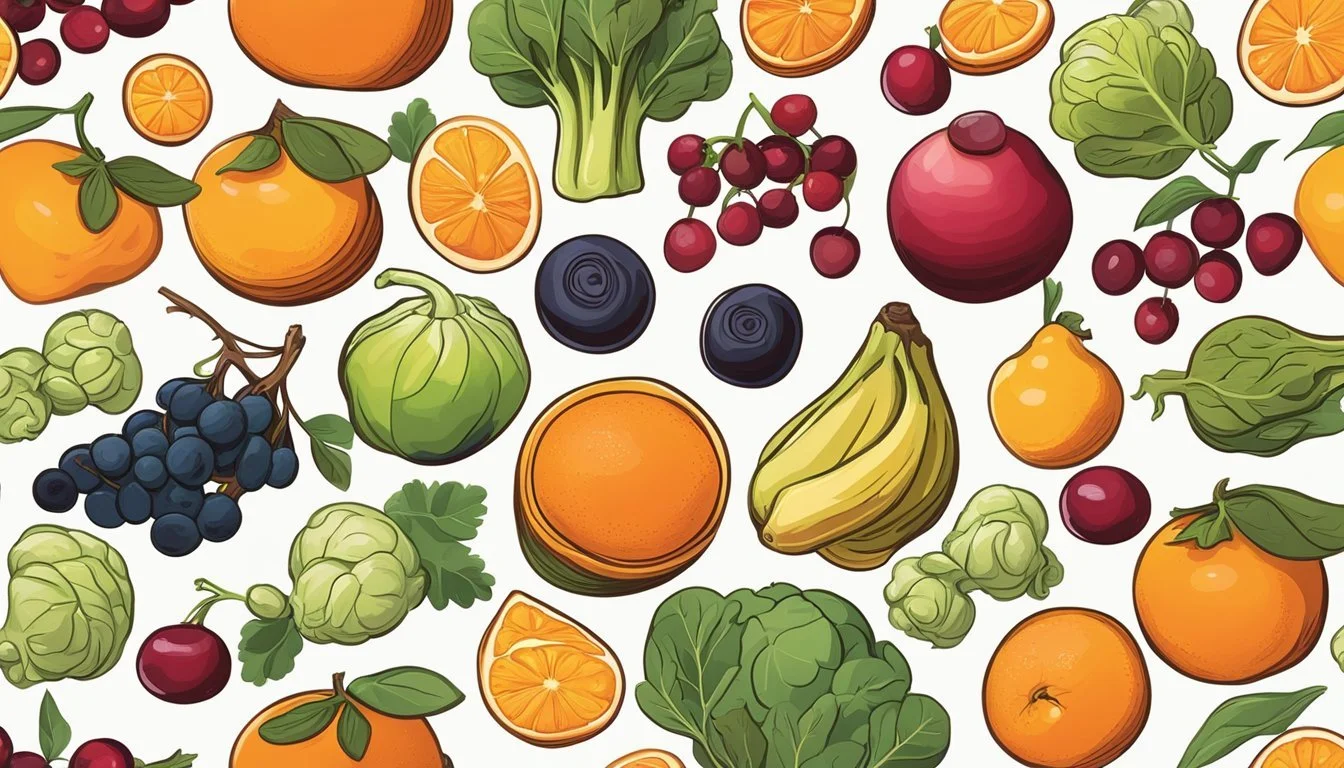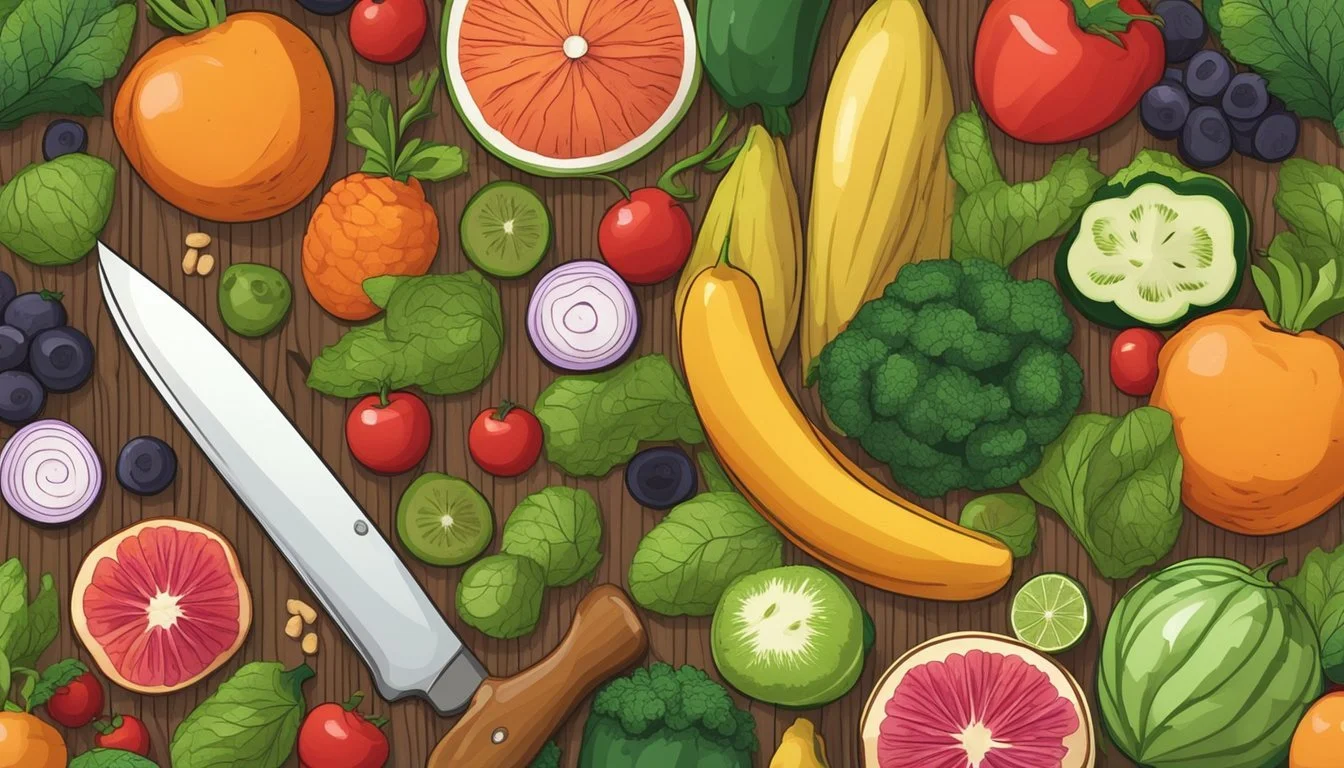Seasonal Fruit and Vegetables December
Your Guide to Fresh Produce
This Article is Part of Our Guide to Seasonal & Local Produce in the USA
Seasonal produce offers a range of benefits, from heightened flavor and nutrition to support for local farming and reduced environmental impact due to decreased shipping requirements. December brings with it a bounty of fruits (What wine goes well with fruit?) and vegetables that are not only packed with nutrients but also embody the taste of the season. Root vegetables and hearty greens commonly thrive in this cooler month, their robust flavors complementing the festive dishes often enjoyed during this time.
Among the fruits that are at their peak in December, one can find varieties such as cranberries, which are a vital part of traditional holiday meals (What wine goes well with holiday meals?), providing both vibrant color and a tart counterpoint to richer fare. Meanwhile, citrus fruits like lemons come into season, offering a burst of freshness and vitamin C that's especially welcome during shorter, colder days.
Vegetables like curly endive and escarole—both part of the chicory family—add a bitter crispness to salads and are excellent when wilted into warm dishes. Root vegetables, such as parsnips, turn nutrient-rich soil into sweet, starchy flavors perfect for roasting or pureeing into soups. These seasonal offerings not only deliver nutritionally but also inspire a host of recipes that resonate with the essence of December's culinary landscape.
What’s in Season in December in Your State?
Texas Seasonal Fruit and Veg in December
Benefits of Eating Seasonally
Eating seasonally offers numerous benefits ranging from improved nutrient intake to supporting a sustainable environment. December's bounty includes foods that are not only rich in flavor but are packed with health-boosting qualities.
Nutritional Advantages
Seasonal fruits and vegetables are often at their peak of freshness, meaning they can provide more nutrients than their out-of-season counterparts. For instance, kiwi, a December fruit, is a powerful source of vitamin C, fiber, and other essential vitamins and minerals. Vegetables harvested during their appropriate season tend to retain higher levels of vitamins and antioxidants, promoting better health.
Environmental Impact
Choosing seasonal produce supports a healthier planet. Foods grown in their natural season require less environmental resources such as water and land. Additionally, eating seasonally can reduce the pollution associated with long-distance transportation and minimizes the need for greenhouse gas-emitting storage facilities.
Economic Benefits
Seasonal produce can be more cost-effective due to the abundance of supply at the peak of its natural growing season. This means consumers can save money while enjoying the freshest possible produce. Farmers also benefit economically from the sustainability of seasonal growing practices, which can preserve their land's productivity over time.
Seasonal Fruit Highlights in December
December brings a bountiful selection of fruits ideal for holiday dishes and winter nutrition. Consumers will find an array of vibrant citrus, crisp pome fruits, and tantalizing tropical options.
Citrus Fruits
The citrus season is in full swing during December, offering an abundance of flavor and vitamin C. Consumers will relish the opportunity to select from a variety of citrus fruits:
Oranges: Standard navels are sweet and juicy, perfect for snacks or juices.
Grapefruit: Ranging from ruby red to white, these are known for their slightly tart taste.
Tangerines: A sweeter alternative to oranges, they are smaller and easier to peel.
Clementines and Mandarin Oranges: These are sweeter and usually seedless, making them great for kids.
Kumquats: Small and oval-shaped, they are eaten whole and have a sweet yet tangy flavor.
Pome Fruits
Pome fruits are at their peak in December, providing crisp textures and a range of flavors:
Apples: Various types like Honeycrisp and Granny Smith are perfect for cooking or eating raw.
Pears: The Bartlett pear, with its signature greenish-yellow color, offers a sweet and juicy option.
Tropical and Exotic Choices
Exotic fruits provide a taste of warmer climates during the cold December months:
Kiwi: This small fruit packs a tangy punch and is dense in nutrients.
Persimmons: They have a unique sweet flavor, often compared to honey.
Pomegranates: Known for their jewel-like seeds that offer a burst of sweet and tart flavors.
Cranberries: Typically harvested in the fall, they can still be found fresh in December, adding a tart flavor to dishes.
Seasonal Vegetable Selections for December
In December, an array of vegetables reach their peak season, offering a combination of robust and subtle flavors. This is a prime time to enjoy a diverse selection of root vegetables and winter squash, as well as a variety of cruciferous and leafy greens.
Root Vegetables
Root vegetables are staples during the colder months due to their ability to be stored through winter. Potatoes are versatile and plentiful, while carrots and sweet potatoes provide a sweet and nutritious option for a multitude of dishes. Additionally, hearty choices like turnips, rutabagas, parsnips, and celery root (also known as celeriac) add depth and nutrition to winter meals.
Turnips: Offer a slightly peppery taste and can be roasted, mashed, or used in stews.
Rutabagas: Sweeter than turnips, ideal for roasting or mashing.
Parsnips: Have a sweet, nutty flavor and are excellent when boiled, roasted, or used in soups.
Winter Squash Varieties
Winter squash, including butternut squash (how long does butternut squash last?), is a highlight of December produce. These vegetables are known for their firm texture and sweet, nutty flavor. They are versatile in the kitchen, commonly roasted, puréed for soups, or baked.
Butternut Squash: Creamy and sweet, suitable for soups and roasting.
Cruciferous Vegetables
Cruciferous vegetables are renowned for their health benefits and include cabbage, cauliflower, and broccoli (how long does broccoli last?). These vegetables are high in vitamins and can be prepared in various ways, from roasting to steaming.
Cauliflower: Roast with spices for a hearty dish.
Broccoli: Best steamed or stir-fried to retain its nutrients and crunch.
Leafy Greens
December also offers a selection of nutrient-dense leafy greens. Kale and spinach are particularly good this time of year, filled with vitamins for a health boost during the winter season.
Kale: Can be sautéd, added to smoothies, or made into chips.
Spinach: Perfect for salads or wilted into warm dishes.
Other December Vegetables
Other vegetables that are excellent in December include artichokes (What wine goes well with artichokes?), fennel, leeks, and radishes. Fennel has a distinctive licorice (how long does licorice last?)-like flavor and can be grated raw into salads or roasted. Leeks add a mild onion flavor to dishes and are delightful when used in soups. Radishes provide a crunchy and peppery element to salads.
Fennel: Slice thin for a crisp addition to salads.
Leeks: Clean thoroughly and use to enhance the flavor in soups and stews.
Cooking Tips and Recipe Ideas
In December, chefs and home cooks alike celebrate winter's bounty, turning seasonal produce into delectable dishes that warm and satisfy. Attention to preparation techniques and ingredient pairings can transform simple recipes into festive culinary creations.
Savoring Winter Produce
Root vegetables and brassicas are stars of the season. Roasting these winter favorites, like beets and Brussels sprouts (how long do brussels sprouts last?), enhances their natural sweetness and creates a caramelized exterior. A simple recipe idea is Roasted Root Vegetables: toss carrots, turnips, and parsnips in olive oil, salt, and herbs before roasting until tender. For Brussels Sprouts, halving and roasting them with a drizzle of balsamic vinegar can serve as a perfect side dish.
Creative Combinations
Winter fruits like oranges and pomegranates add a burst of freshness to any dish. They complement both sweet and savory flavors, making them versatile for a range of recipes. Incorporating citrus segments into a kale salad introduces a vibrant note, while pomegranate seeds (how long do pomegranate seeds last?) can top desserts for a festive touch. For a delightful Holiday Pasta, one might mix roasted butternut squash, torn kale, and pomegranate seeds with cooked pasta and a hint of orange zest.
Preparing Festive Dishes
The holiday season calls for special dishes that gather family around the table. Traditional Stews and Soups made with seasonal vegetables like rutabagas and kohlrabi are not only filling but also imbue the home with comforting aromas. Desserts often take center stage, with options such as a Clementine and Pomegranate Tart. For the family brunch, Winter Fruit Smoothies with frozen berries and a dash of cinnamon can be a healthy and refreshing start to the day.
Selecting and Storing Tips
When shopping for seasonal produce in December, it is crucial to know how to identify the freshest options at markets and how to store them properly to ensure they maintain their quality. Understanding these aspects ensures one enjoys the full nutritional and taste benefits of winter produce, often available at your local farmers market.
Choosing the Freshest Options
When at the market, one should look for fruits and vegetables with vibrant colors and firm textures. Avoid any items with bruises or soft spots, as these may be indicators of spoilage. For example, citrus fruits like clementines and grapefruits should feel heavy for their size, signaling juiciness. Broccoli rabe should have crisp, green leaves, and its cut ends should not look dried out. Sweet potatoes are a smart choice, seeing as they are often in abundant supply; one should opt for the ones with smooth, unblemished skins.
Storage to Maintain Freshness
Fruits:
Citrus: Store in a cool place, away from direct sunlight; they can last for up to two weeks.
Tart fruits: Typically last well in a refrigerator's crisper drawer.
Vegetables:
Root vegetables (e.g., sweet potatoes): Store in a cool, dark place with good ventilation.
Leafy greens (e.g., kale, broccoli rabe): Refrigerate in a loose plastic bag with a paper towel to absorb excess moisture.
Extending Shelf Life
To extend the shelf life of your produce, proper sealing and storage are key. Use airtight containers or resealable plastic bags to keep air and moisture out. Some vegetables, like rutabagas and carrots, can be stored in the crisper drawer of your refrigerator. This will maintain their firmness and prevent them from wilting or getting rubbery. Regularly check your stored fruits and vegetables for signs of spoilage and consume them in a timely fashion to avoid waste.
Understanding Food Seasonality
As winter approaches, it's crucial to identify fruits and vegetables that are in season. Shoppers can benefit from local markets offering fresh, nutrient-rich produce while using seasonality charts as a guide to better plan their diets.
Identifying Seasonal Foods
Fruits in season: In December, consumers will find a range of winter fruits at their peak. These include the Envy™ apple, cranberries—which are harvested in the fall and fresh into early winter—and vegetables like kale, which remain nutritious through colder months.
Vegetables in season: Vegetables like Brussels sprouts and broccoli are also available and offer maximum flavor and nutritional benefits. Root vegetables, such as parsnips, are hardy and ideal for winter dishes.
Benefits of Local Food Markets
Local food markets provide access to the freshest seasonal produce. They support regional farming communities and offer a variety of fruits and vegetables that are often picked at their peak ripeness, thereby providing better flavor and nutritional value. For instance, shopping at a local market ensures that items like cranberries are as fresh as possible, having been transported over shorter distances.
Seasonality Chart Guide
A seasonal chart is a powerful tool for consumers to use. It informs them about the seasonality of produce, which can vary depending on the region's growing conditions and weather patterns.
Winter Fruits:
Apples
Cranberries
Strawberries (in some warmer climates)
Winter Vegetables:
Kale
Brussels Sprouts
Broccoli
Parsnips
Chicories like curly endive and escarole
Shoppers are encouraged to consult such guides to enhance their meal planning and support sustainability by prioritizing in-season produce.






